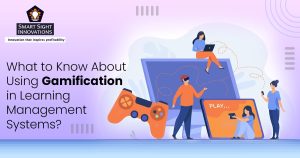 There are many engaging game-like interfaces, interactions and quizzes to facilitate and promote learning in the online learning environment. Gamification encourages participation and program completion by offering rewards and recognitions. They have grown to be an essential component for training employees.
There are many engaging game-like interfaces, interactions and quizzes to facilitate and promote learning in the online learning environment. Gamification encourages participation and program completion by offering rewards and recognitions. They have grown to be an essential component for training employees.
Even if technology and digital games are recent innovations, games have been used for years to teach and enhance methods and people’s thought processes. Gamification in learning refers to the integration of gaming aspects into educational activities. Research has demonstrated the benefits of gamification in our daily activities for mental wellness.
In the realm of modern education, the integration of technology has revolutionized the way students and professionals approach learning. Among the myriad innovative tools, gamification has emerged as a powerful and engaging method to enhance the educational experience.
By harnessing the principles of game design and applying them to learning contexts, gamification presents a novel approach that captivates learners, fosters intrinsic motivation, and enhances knowledge retention.
Several higher education institutions offer at least one learning management system (LMS) for organizational and learning support. If done properly, the advantages of gamification can be astounding.
What Is Gamification?
Gamification is a dynamic and innovative educational approach that utilizes principles derived from game design to enhance engagement, motivation, and learning outcomes. It involves integrating game-like elements, mechanics, and dynamics into non-game contexts, such as education, corporate training, and personal development, with the aim of encouraging active participation and rewarding desired behaviors.
At its core, gamification leverages the intrinsic human desire for achievement, competition, and recognition to create a captivating and immersive learning experience. By incorporating elements like points, badges, leaderboards, levels, challenges, and rewards, it transforms mundane tasks into interactive and enjoyable activities.
These elements act as powerful incentives, inspiring learners to overcome obstacles and progress further, while providing immediate feedback that reinforces positive behaviors and fosters a sense of accomplishment. One key aspect of gamification is the element of choice.
It allows learners to navigate their learning journey at their own pace, making decisions that shape their individual experiences. This autonomy empowers learners, promoting a sense of ownership over their education and fostering a deeper commitment to the learning process. Gamification’s effectiveness also lies in its ability to tap into emotions.
By creating an emotional connection through storytelling, themes, and characters, gamified learning experiences become memorable and relatable. Learners develop a sense of empathy and attachment to the content, which enhances retention and application of knowledge.
Moreover, gamification facilitates a sense of camaraderie and social interaction. The use of leaderboards and collaborative challenges encourages healthy competition and cooperation among learners, promoting teamwork and peer support.
This social aspect not only makes learning enjoyable but also enhances the overall learning experience through knowledge-sharing and collective problem-solving. It is important to note that gamification is not about replacing traditional educational methods but rather supplementing them with a dynamic and effective approach.
When thoughtfully integrated into learning environments, gamification can significantly boost learner engagement, motivation, and knowledge retention.Gamification represents a paradigm shift in the way we approach education and skill development.
By harnessing the principles of games, this innovative approach captivates learners, instills a sense of achievement, and fosters a genuine passion for learning. As technology continues to advance, gamification is expected to play an increasingly vital role in shaping the future of education and training, empowering learners of all ages and backgrounds to unlock their full potential in an enjoyable and rewarding manner.
Gamification is frequently used by businesses to improve organizational efficiency, employee training, hiring and evaluation. Other applications include voter participation, physical exercise and customer loyalty programs. Productive gamification will combine external motivations like prizes, points and badges with internal motivations like improving one’s job-related skills.
Examples of Successful Implementation of Gamification Techniques
Gamification techniques have been successfully implemented in various fields, showcasing their potential to revolutionize learning, employee engagement, and customer interactions. Below are some notable examples of successful gamification implementations:
1. Duolingo
Duolingo, a popular language-learning platform, exemplifies how gamification can transform the process of acquiring new skills. The learning application employs game-like features, such as leveling up, earning points, and streaks for consecutive days of learning, to keep learners motivated and engaged.
Users feel a sense of achievement as they progress through levels and receive rewards, making language learning enjoyable and addictive.
2. Nike+ and Fitness Apps
Fitness apps, including Nike+, have incorporated gamification techniques to motivate individuals to stay active and maintain healthy habits. Users earn badges for accomplishing specific milestones, compete with friends on leaderboards, and engage in challenges.
These features foster a sense of competition, encouraging users to push their boundaries and maintain consistency in their fitness routines.
3. Starbucks Rewards Program
Starbucks’ loyalty program is a prime example of gamification in the retail sector. Customers earn stars for each purchase, and as they accumulate stars, they unlock various levels of rewards, such as free drinks and discounts. This gamified rewards system incentivizes repeat visits and fosters customer loyalty.
4. Khan Academy
Khan Academy, an online educational platform, utilizes gamification to enhance the learning experience for students. By completing lessons and assessments, learners earn points and badges, and their progress is tracked on a personalized dashboard. This motivates students to engage actively with the content and track their academic growth.
5. Microsoft’s Ribbon Hero
Ribbon Hero is an add-on game for Microsoft Office, designed to help users explore and learn the features of the Office suite. Players are presented with challenges that encourage them to use different tools and features, turning the learning process into an enjoyable and interactive experience.
6. IBM’s CityOne
IBM’s serious game, CityOne, applies gamification principles to tackle real-world challenges related to urban planning, energy management, and logistics. Players take on the role of city managers, making decisions to improve the city’s sustainability and resilience. By gamifying the problem-solving process, IBM educates users on complex issues while promoting innovative thinking.
7. Foldit
Foldit is an online game developed by the University of Washington, where players solve puzzles related to protein folding. By gamifying the task, the game has led to significant breakthroughs in biochemistry, as players were able to decipher complex protein structures that had eluded scientists for years.
8. Cisco
Cisco used gamification to motivate its workforce to understand social media by organizing training programs. They simplified the procedure by engaging users and implementing a learning route divided into three levels of certification, obtaining points and badges along the way and team challenges.
Gamification in Learning Management System (LMS)
Gamification has evolved into a crucial component of any effective LMS. When learners initially sign into their LMS, they might not be familiar with gamification or how its features operate. They become more proficient, engaged and knowledgeable about the gamification elements as they become more accustomed to the LMS user interface.
Knowing the process and content of LMS will help learners become experts in gamification. The process of gamification in a LMS are as follows:
- When the learner logs into the LMS, a message outlining the advantages of the learning initiatives is displayed. Learners are given numerous questions to answer before learning how it can benefit them.
- The LMS’s gamification elements are demonstrated to learners during an orientation.
- All learner activities, such as login information, profile updates, social interaction, formal learning, contributions and participation in discussion forums are tracked by the LMS. This gives learners a chance to earn rewards or points.
- Designers typically include progress bars that motivates learners to check their scores and directs them to finish a certain level to obtain more badges.
- The LMS interface grants and displays rewards, points, badges or certificates depending on the activities or lessons performed in appealing designs.
- Learners will receive email notifications and push notifications on their mobile devices informing them of their progress and inviting them to take part in the learning activities.
- The use of games in education promotes both competition and teamwork. Giving students recognition for their contributions, accomplishments and engagement is motivating and interesting.
Benefits of Gamification in LMS
-
Engagement and Motivation
Implementing gamified components into a LMS aims to attract the learner’s attention and inspire them to complete the tasks assigned to them by promoting healthy competition and making learning interesting and interactive.
-
Retention and Recall of Information
Learning and development in professional or academic settings can become monotonous and limits the amount of information that is retained. Gamification helps to solve this issue. Student’s memory of the course information is improved by its repetition and encouragement of active learning.
-
Improved Social Learning and Coordination
Gamification enhances social learning and teamwork by incorporating game mechanics into non-game situations. By motivating individuals to engage in conversation, exchange information and work together to find solutions to problems, it promotes engagement, competition and cooperation.
-
Real-Time Evaluations and Performance Monitoring
Both the learner and the instructor can see how much they have gained at each level, with the help of gamification elements like points or progress bars. This offers real-time input on areas for improvement while also assisting in performance monitoring.
-
Learning Experiences
Gamification allows learners to customize their learning experiences by using game elements like points, levels, prizes and leaderboards. Learners can set their objectives and advance at their speed. Additionally, it allows learners to continue learning even after the formal instruction has ended.
-
Enhanced ROI and Business Outcomes
Businesses are aware that employees value the chance to learn new skills. An excellent way to increase your training options and the overall learning experience for your team members is to combine a LMS with gamification.
Gamification represents a paradigm shift in the way we approach education and skill development. By harnessing the principles of games, this innovative approach captivates learners, instills a sense of achievement, and fosters a genuine passion for learning.
As technology continues to advance, gamification is expected to play an increasingly vital role in shaping the future of education and training, empowering learners of all ages and backgrounds to unlock their full potential in an enjoyable and rewarding manner.
The gamification experience in a LMS should be carefully planned and created or the learners may feel less engaged and lose interest. It can be used effectively in both e-learning and traditional classrooms. It gets individuals actively participating rather than just being passive recipients of material.
Dropouts, failures and a lack of enthusiasm in the learning program are caused by poor interaction by the learner with the learning management system. Gamification is shown to boost interest and inspire learners additionally improving traits like perseverance, inventiveness and resilience.
Gamification offers tools that deliver outcomes that are worthwhile for investments. Instead of unclear and inconsistent long-term benefits, the gamification of learning must give learners clearly-defined duties with immediate rewards.














